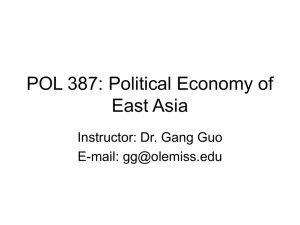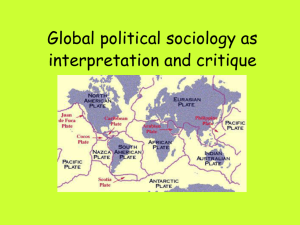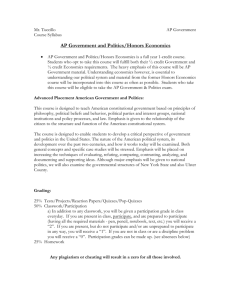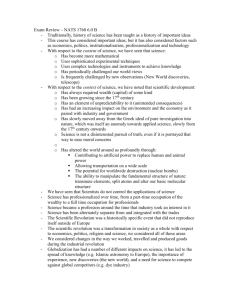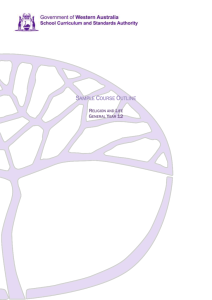Sociology 545 Social Psychology
advertisement
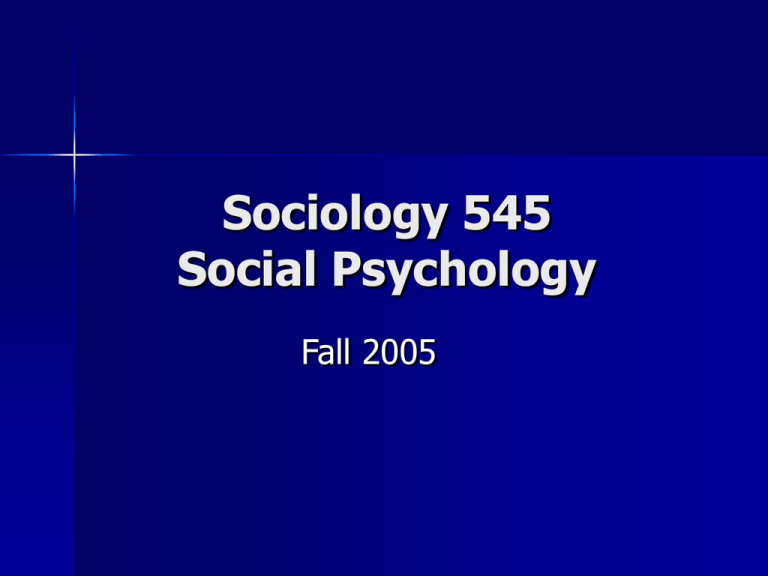
Sociology 545 Social Psychology Fall 2005 Social Institutions Definition Basic Considerations The Law and Politics Markets and Economics Education and Mobility Religion and Belief Social Institutions Definition: “Structures in society, manifested as groups of social positions and associated social relations, invested with legitimate authority, that serve to maintain and carry out essential social functions and perpetuate the social order. “ Social Institutions Basic Considerations All institutions are structures composed of social groups. A condition of social groups is the interrelationship of statuses. All statuses are reflected in role behavior Role behaviors are cognitively mediated by their occupants. Hence, institutions are cognitively mediated structures. Social Institutions The Law and Politics Social Institutions (Law and Politics) Approaches to Deviance – Structural (e.g. Merton’s Structural Strain) Innovator desires ends but hasn’t the means – Cognitive (e.g. Becker’s Labeling) Attributions via sanctioned legal process Social Institutions (Law and Politics: The Judicial Structure) Court System Federal: - The Supreme Court (1 @ 9) Court of Appeals (11 @ 3) District Courts (94 @ 1) Bankruptcy Courts (94 @ 1) State: - Superior (58 @ 1) merged with municipal in 2001 Social Institutions (Law and Politics: The Judicial Structure) State Court System – Superior Court (58 @ 1) One for each county – Municipal Court Merged with Superior Courts in 2001 Social Institutions (Law and Politics) The Criminal Process Arrest Preliminary Hearing Arraignment Pre-Trial Hearings Trial Verdict Sentencing Incarceration Parole Social Institutions (Law and Politics) Social Psychological Considerations Arrest and Arraignment – Memory / Cognitive consistency Pre-Trail and Trial Judgments – Attribution of cause / Distributive Justice Sentencing Practices – Labeling / Status Characteristics and Expectation states Social Institutions Markets and Economics Social Institutions (Markets and Economics ) Approaches to Markets – Structure (Adam Smith - Supply/Demand) Production, Distribution & Consumption – Process (Arrow – Rational Choice) Interpersonal Utility. Risk Preference Social Institutions (Markets and Economics) Disintermediation and The Monetary System: – The Federal Reserve – 13 Districts – Debt – Banks / Bonds – Equity – Stocks / VC Social Institutions (Markets and Economics) Social Psychological Considerations Production, Distribution & Consumption – Utility / Exchange Equity Risk Preference – Opportunity Costs / Comparison Level GNP – Generalized Exchange Social Institutions (Markets and Economics) Risk Preference Salience Reward Value CL Risk Social Institutions (Markets and Economics) Money and Meaning: Earned Income Wages, Salaries Unearned Income To 40% To 77% Dividends, Interest Capital Gains Taxes Real & Personal Property To 28% Social Institutions Education and Mobility Social Institutions (Education and Mobility) Structure (Status Attainment Model) – Parents Status, Education & 1st Job status Family SES Ambition Education Ability Grades Social Institutions (Education and Mobility) Social Psychological Considerations Attribution and achievement – Status Characteristics and Success Attribution Costs, Reward & Delayed Gratification – Delay as Dissonance Reduction Role Modeling – Role Self Merger Social Institutions (Education and Mobility) Process (Soc Psych Model) Role Modeling Delayed Gratification Family SES Ambition Education Ability Self Attribution Grades Social Institutions Religion and Belief Social Institutions (Religion and Belief) Structure – Hierarchically Organized (Bureaucracies) – Bound by Symbols, Belief and Ritual Symbols Organizations Ritual Beliefs However, cognitive mediation => disassociation from task => rise of denominations and ultimately cults and sects, where the membership is based more on the beliefs, symbols and ritual than on the organizational membership. Social Institutions (Religion and Belief) Social Psychological Considerations Belief – Dissonance Reduction Symbols – Significant Symbols Ritual – Intermittent Reinforcement / Reward Social Institutions (Religion and Belief) • Process (Soc Psych Model) S-I’s Significance Intermittent Rewards Symbols Ritual Beliefs Dissonance Reduction Organization
